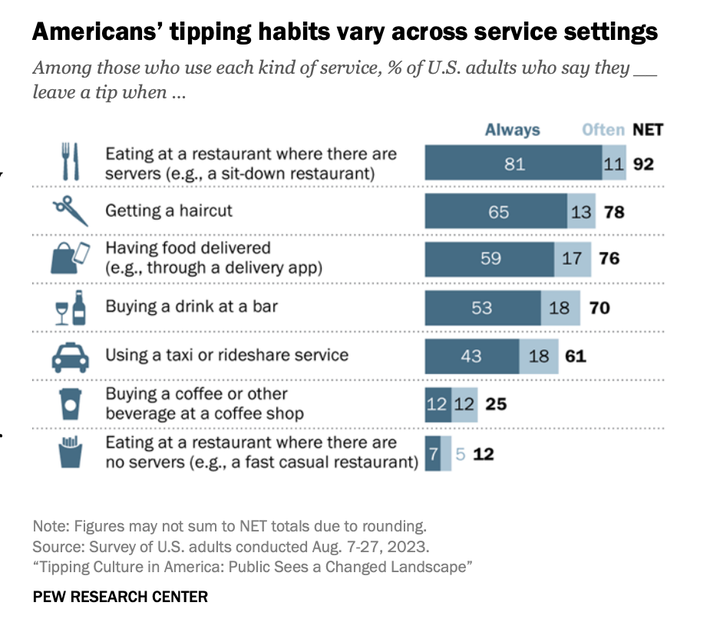If you feel like you’re expected to tip more often these days but no longer know what the guidelines are, you have plenty of company out there.
Most U.S. adults believe the expectation to tip has increased in the last few years, yet they feel a lot of uncertainty about when to leave gratuities and how large they should be, according to a new survey from the Pew Research Center.
More than 70% of the August survey’s respondents said it feels like more businesses expect their workers to be tipped than five years ago. But only around a third of respondents said it was very easy to know whether to leave a gratuity in a given situation, and roughly the same share said it was very easy to know how big it should be.
Respondents also said they were far more likely to tip certain service workers than others. More than 90% said they always or often leave a tip for a restaurant server, but only 76% said the same for an app-based delivery worker, 61% for a ride-share driver, and just 25% for a coffee shop barista.

Drew DeSilver, a Pew writer who analyzed the survey results, told HuffPost the findings dovetail with anecdotal evidence of a tipping culture shift ― sometimes dubbed tipflation, tip creep or tipping fatigue ― in which customers feel more pressure, often through point-of-sale touch screens, to leave gratuities for a wider swath of services. (The pilot episode of HuffPost’s new podcast “Am I Doing It Wrong?” explored the confusion around tipping in today’s service economy.)
“It’s one of those things where you have a feeling you know what’s going on but there’s not really a way to quantify that,” DeSilver said. “Certainly the perception is that people are being asked to tip in more places.”
DeSilver cautioned that the tipping survey has a drawback: This is the first year Pew has done it, so researchers couldn’t perform an apples-to-apples comparison with survey results from prior years. But he said they tried to frame the survey in a way that would capture whether people feel as though tipping expectations have changed.
He said the results reflected a lot of uncertainty around the custom.
“A lot of people say it is not particularly easy to know when to tip or how much to tip,” he said. “There is no authoritative single source on what the rules of tipping are.”
The survey also found that people generally don’t like being prompted with suggested tip amounts (40% oppose this practice, compared with 24% who favor it), and they very much dislike automatic tips or service charges (72% said they oppose them regardless of the size of their party). More restaurants seem to be adding automatic charges to bills ― sometimes dubbed service fees or even “living wage” fees linked to minimum wage increases ― though they don’t always go to the workers.
Meanwhile, a strong majority overall (72%) said they believe the tips they leave should stay with the restaurant worker who served them. However, this is often not the practice in restaurants that run tip pools and spread the gratuities among other front-of-the-house workers, like bartenders and food runners.
Most respondants (77%) said they factor the quality of the service they received into how much of a tip they will leave. Only a quarter said a worker’s pre-tip wages serve as a major factor. Many tipped workers are paid a sub-minimum wage ― as low as $2.13 per hour in some states ― with gratuities expected to make up the difference.
One of the more surprising findings for DeSilver: A majority of respondents said they were likely to tip 15% or less on a sit-down meal at a restaurant. Only a quarter said they would tip 20% or more.
He expected most people to land in the 18% to 20% range.
“I generally thought that was the norm,” he said.

